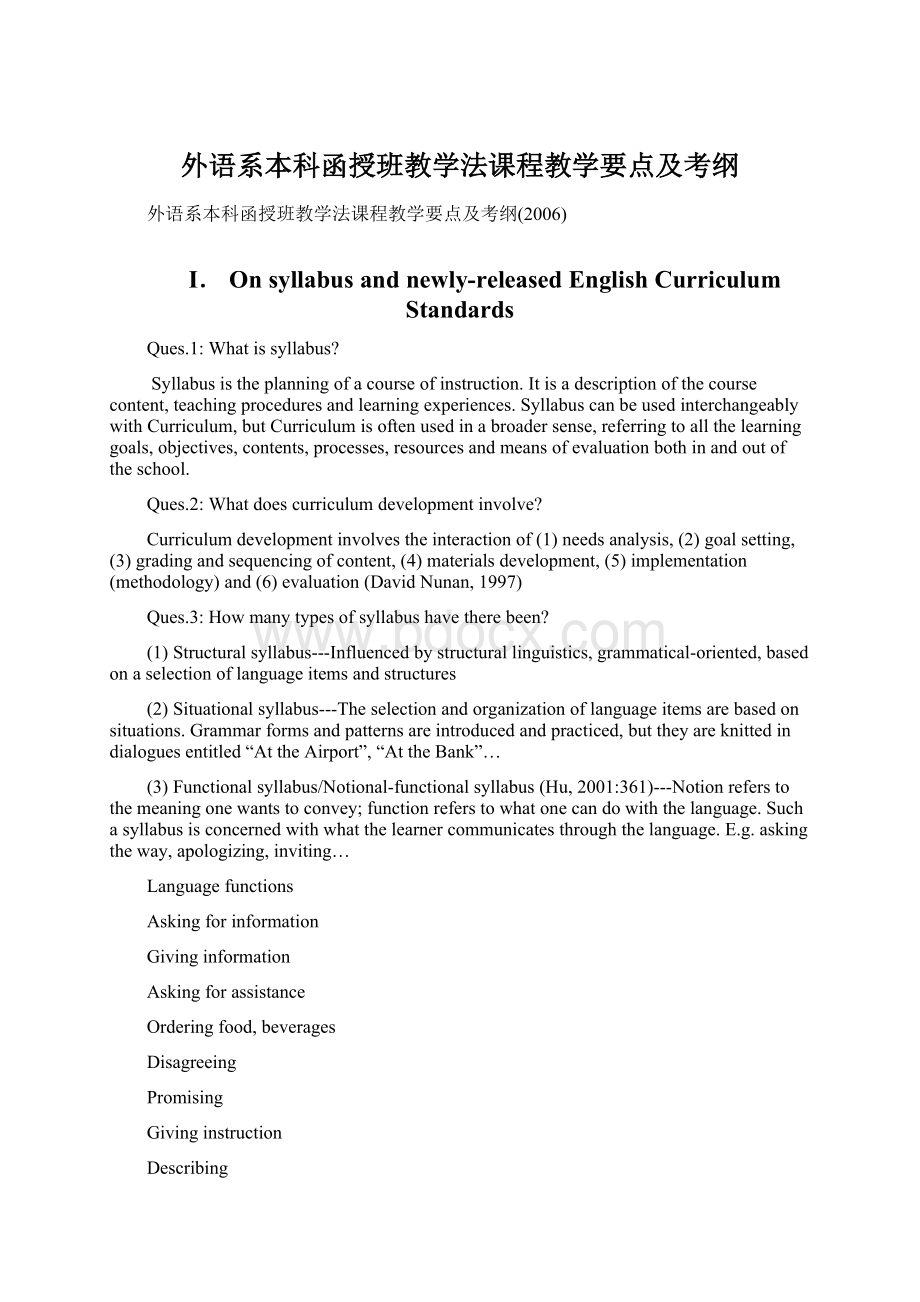外语系本科函授班教学法课程教学要点及考纲Word格式文档下载.docx
《外语系本科函授班教学法课程教学要点及考纲Word格式文档下载.docx》由会员分享,可在线阅读,更多相关《外语系本科函授班教学法课程教学要点及考纲Word格式文档下载.docx(14页珍藏版)》请在冰豆网上搜索。

Languagefunctions
Askingforinformation
Givinginformation
Askingforassistance
Orderingfood,beverages
Disagreeing
Promising
Givinginstruction
Describing
Politeconversation
(4)Communicativesyllabus---Itpaysmoreattentiontotheappropriateuseoflanguagesoastoachieveeffectivecommunication.
(5)Topicsyllabus
Topics
Personalidentification
Travel
Meals
Taxis,automobiles
Traffic
Hiringstaff
Findingahouse
Runningahouse
Foods,beverages
Shopping,buying
Clothing,jewelry
Entertainment
(6)Skillssyllabus
(7)Contentsyllabus---Focusingonthecontent/subject-matter,notontheskills,noronthestructures;
conveyingavarietyofsubjectstoattractthestudents.
(8)Task-basedsyllabus---Learningbydoing;
learningbyusing
(9)Multi-syllabus/mixedsyllabus---Productandprocess,knowledgeandskills,languageobjectivesandnon-languageoutcomes(affectsandattitudes)arevalued.EnglishNationalCurricularCriteriabelongstomulti-syllabus(程晓堂,2005:
70-71)
既重视结果也重视过程;
既重视知识也重视技能;
既重视语言目标也重视非语言目标。
SomemorequestionsaboutthenewEnglishCurricularCriteria:
1.WhatisthemostessentialunderlyingphilosophyofthenewCurricularCriteria?
Human-based,studentdevelopmentbased.
2.Fromwhataspectsdoesitspecifythecourseobjectives?
Fromfiveaspects:
Languageskills,linguisticknowledge,affectandattitude,learningstrategies,cultureawareness.
3.Whatkindsofteachingmethodsandwhattypesoflearningstylesdoesitadvocate?
TBLT,autonomouslearning,cooperativelearninganddiscoverylearning.
4.Whatabilitiesdoesitstress?
1)informationcollectingandinformationprocessing;
2)problemanalysisandproblemsolving;
3)thinkingandexpressingideasinEnglish.
5.Whatmeansofassessmentdoesitpropose?
Acombinationofformativeassessmentandsummativeassessment.
II.Viewsonlanguageandviewsonlanguagelearning
●LanguageTheories(P.3)
1.Thestructuralviewonlanguage
Thestructuralviewseeslanguageasalinguisticsystemmadeupofvarioussubsystems:
fromphonological,morphological,lexical,etc.tosentences.Eachlanguagehasafinitenumberofsuchstructuralitems.Tolearnalanguagemeanstolearnthesestructuralitemssoastobeabletounderstandandproducelanguage.
2.Thefunctionalviewonlanguage
Thefunctionalviewseeslanguageasalinguisticsystembutalsoasameansfordoingthings.Mostofourday-to-daylanguageuseinvolvesfunctionalactivities:
offering,suggesting,advising,apologizing,inviting,ordering,complaining,etc.Therefore,learnerlearnsalanguageinordertodothingswithit.Toperformfunctions,learnersneedtoknowhowtocombinethegrammaticalrulesandthevocabularytoexpressnotionsthatperformthefunctions.Examplesofnotionsareconceptofsuchastime,duration,quantity,specificationofthings(present,past&
futuretime;
expressionsofcertaintyandpossibility;
therolesofagentandinstrumentwithinasentence;
andspecialrelationshipsbetweenpeopleandobjects)
3.Theinteractionalviewonlanguage
Theinteractionalviewconsiderslanguageasacommunicativetool,whosemainuseisbuildupandmaintainsocialrelationsbetweenpeople.Therefore,learnersnotonlyneedtoknowthegrammarandvocabularyofthelanguagebutasimportantlytheyneedtoknowtherulesforusingtheminawholerangeofcommunicativecontexts.
●Languagelearningtheories(P.5)
1.Behavioristtheory---(habitformation:
S---R)
2.Cognitivetheory---methodsinwhichstudentsareaskedtothinkratherthansimplyrepeat.
3.Autonomouslearning---Thelearnerscantakeresponsibilityfortheirownlearningandevaluatetheirlearningoutcome.
4.Cooperativelearning—AlsocalledCollaborativelearning.Itisanapproachtoteachingandlearninginwhichclassroomsareorganizedsothatstudentsworktogetherinsmallcooperativeteams.Suchanapproachtolearningissaidtoincreasestudents’learningsincea)itislessthreateningformanystudents,b)itincreasestheamountofstudentparticipationintheclassroom,c)itreducestheneedforcompetitiveness,andd)itreducestheteacher’sdominanceintheclassroom.Fivedistinctivetypesofco-operativelearningactivitiesareoftendistinguished.
1)peertutoring:
studentshelpeachothertolearn,takingturnstutoringordrillingeachother.
2)Jigsaw:
eachgroupmemberofagrouphasapieceofinformationneededtocompleteagrouptask.
3)cooperativeprojects:
Studentsworktogethertoproduceaproduct,suchasawrittenpaperorgrouppresentation.
4)co-operative/individualized:
Studentsprogressattheirownratethroughindividualizedlearningmaterialsbuttheirprogresscontributestoateamgradesothateachpupilisrewardedbytheachievementsofhisorherteammates.
5)Studentsworktogetherasateamtocompletealearningunit,suchasalaboratory
experiment.
CooperativelearningactivitiesareoftenusedinCommunicativeLanguageTeaching(JackC.Richardsetal,2000:
109).
5.Discoverylearning---Anapproachtoteachingandlearningwhichisbasedonthefollowingprinciples:
a.Learnersdevelopprocessesassociatedwithdiscoveryandinquirybyobserving,inferring,formulatinghypotheses,predictingandcommunicating.
b.Teachersuseateachingstylewhichsupportstheprocessesofdiscoveryandinquiry.
c.Textbooksarenotthesoleresourcesforlearning.
d.Conclusionsareconsideredtentativeandnotfinal.
e.Learnersareinvolvedinplanning,conducting,andevaluatingtheirownlearningwiththeteacherplayingasupportingrole.
Anumberoflanguageteachingapproachesmakeuseofdiscovery-basedapproachestolearning,particularlycommunicativelanguageteachingandtheSilentWay.
●Therelationshipbetweenlanguagetheories,learningtheoriesandlanguageteachingapproaches.
Yourviewsonlanguagearethebasisforsyllabusdesign,teachingmethods,teachingproceduresintheclassroomandeventhetechniquesused.
Differentviewsonlanguagegeneratedifferentteachingmethodologies.
E.g.
TheGrammar-TranslationMethod
TheDirectMethod(TheNaturalOrderofAcquisition)
TheAudiolingualMethod(Audiolingualism)
TheCognitiveApproach
CommunicativeLanguageTeaching
Task-basedLanguageTeaching
●WhatarethequalitiesofagoodEnglishteacher?
(P.6)
Thereareavarietyofelementsthatcontributetothequalitiesofagoodlanguageteacher.Theseelementscanbecategorizedintothreegroups:
ethicdevotion,professionalqualitiesandpersonalstyles(Parrot,1993):
kinddynamicauthoritativespeakingclearly
creativepatientwell-informedhardworking
resourcefulattentivewarm-heartedwell-prepared
flexibleintuitiveaccurateenthusiastic
humorouscaringdisciplinedprofessionally-trained
III.Schoolsofmethodologiesandtheunderlyingtheories
ThemainEnglishTeachingMethodsandApproaches
Methods
Birthtime&
Advocates
Theories
Maincharacteristics
T’srole&
Ss’role
18thcentury
Structuralview,
ThewayofteachingLatin.
1.Translateeverysentenceintonativelanguageandviceversa.
2.Putthegeneralideaofthetextintonativelangue.
3.Teachgrammarinadeductiveway.
4.Vocabularyandliterarylanguagereceivemuchattentionwhilepronunciationreceiveslittleattention.
5.Thereislittlestudent-studentinteraction.
T’sbeingtheauthoritywhileSsbeingtheknowledgerecipient.
TheDirectMethod
Mid-19thcentury
Guin
Naturalmethodofacquisition
1.Userealobject,picture,gestureorotherbodylanguagetoconveymeaning.
2.Imitation,readaloud,askandanswerquestionarethemainactivities.
3.SSareaskedtoanswerquestionsinfullsentence.
4.Grammaristaughtinductively.
5.Errorsareregardednaturalandunavoidableandcanbeself-correctedbySs.
6.Vocabularyandpronunciationreceivemuchattention.
Partnerorcooperator
TheSituationalMethod
1920s-1960s
Palmer,Hornby,Pittman,Alexander
Imitators,Models
TheAudiolingualMethod
√
1940s:
WWII
1.Itattendstostructureandformmorethanmeaning.
2.Languageitemsarenotnecessarilycontextualized.
3.Languagelearningislearningstructures,soundsorwords.
4.Drillingisacentraltechnique.
5.Thestudentsfirstlistentoamodeldi